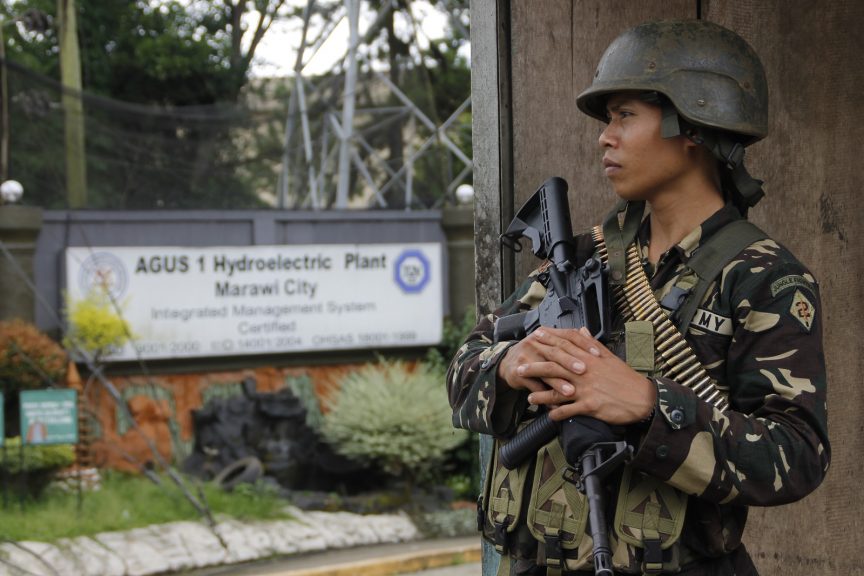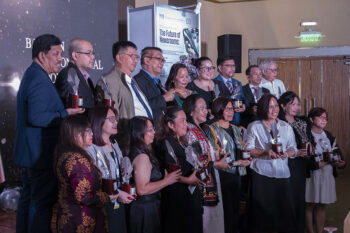 A soldier stands guard outside the Agus 1 hydropower plant in besieged Marawi City on June 25, 2017. The Agus facility is Mindanao’s main source of hydropower. MindaNews file photo by H. MARCOS C. MORDENO
A soldier stands guard outside the Agus 1 hydropower plant in besieged Marawi City on June 25, 2017. The Agus facility is Mindanao’s main source of hydropower. MindaNews file photo by H. MARCOS C. MORDENO
DAVAO CITY (MindaNews/18 August) – A Hong Kong-based Danish investor is eyeing to pour in some P400 million for the construction of a 12-megawatt renewable energy plant in Bukidnon in Northern Mindanao.
In an interview with reporters Friday, Anders Haagen, Gloria Mundi Energy Farming Inc. chief executive officer, said that they will start as soon as the Department of Energy (DOE) issues the permit for the construction of the plant that will take 18 months.
He said the plant will require pearl millet-napier grasses, a hybrid imported from Malaysia, that will be mixed with wastes from corn and rice mills to be fed into the plant to produce power.
He said they have a nursery in Palawan reproducing the hybrid grass that will be distributed to farmers.
He added they will help the farmers with fertilizers and harvesting equipment once plant operations start.
But Haagen said they discourage farmers from intercropping the grass with other crops because the field on which it is planted will be similar to a sugar cane’s.
“You cannot intercrop with sugar cane,” he said.
He said they will tap the Bukidnon farmers, either through land lease or contract growing, to provide the necessary volume of 300,000 tons a year, a development that he sees will help them earn more “than they will with any other crop.”
“If you consider a barangay or municipality on its own, today when they buy electricity what happens? Well, they say essentially fuel is paid. They have to buy coal. Because that’s an import and no job is created in the municipality for the power. Almost none. They just buy it off the grid,” he said.
“You get power lines and you don’t know who makes it for them but I can assure you it’s coal. Now, what happens when I make renewable energy? We grow on their farms and we pay them more than they earn with banana and other crops,” he said.
He explained farmers are basically “growing their own electricity” with no more coal import that costs much higher compared to renewable power source.
“They are making it themselves, so the money stays in the municipality,” he said.
The DOE has been batting for more renewable energy sources in the country.
National Renewable Energy Board chair Jose Layug Jr. said they want to increase the contribution of renewable power from 24 percent to 35 percent, or at least 9,000 to 10,000 MW, to the country’s overall power mix by 2030.
During the Renewable Portfolio Standards public consultation at the SMX Convention Center Davao last July 26, Layug said he wanted renewable energy investors in Mindanao as the cost of clean power sources are starting to go cheaper.
He said he wanted the Mindanao power mix to go back to what it used to be — 70 percent renewable and only 30 percent non-renewable.
“Our preference of course is to have more renewable energy,” he stressed then.
Republic Act 9513 promotes the development, utilization and commercialization of renewable energy resources, specifically biomass waste-to-energy technology, wind, solar, hydropower, ocean, and geothermal.
Based on the 2016 DOE report, non-renewable energy accounts for over half of Mindanao’s power mix, a reversal from what it used to be at least a year ago when renewable energy, mostly hydro, was the island’s main power source.
 The coal-fired power plant in Barangays Libertad and Tacub in Kauswagan town, Lanao del Norte is targeted to start operations this year with a capacity of 540 megawatts. Environmentalists have warned against pollution caused by coal-fired power plants. Photo taken on July 10, 2017. MindaNews file photo by H. MARCOS C. MORDENO
The coal-fired power plant in Barangays Libertad and Tacub in Kauswagan town, Lanao del Norte is targeted to start operations this year with a capacity of 540 megawatts. Environmentalists have warned against pollution caused by coal-fired power plants. Photo taken on July 10, 2017. MindaNews file photo by H. MARCOS C. MORDENO
Of Mindanao’s total installed capacity of 3,162 megawatts, the contribution of non-renewable energy is 1,898 MW (1,070 MW coal and 828 MW diesel), which accounts for 60 percent of the energy mix. Renewable sources, meanwhile, account for only about 40 percent with a contribution of 1,264 MW (108 MW geothermal, 1,061 MW hydro, 36 MW biomass, and 59 MW solar).
Majority of the hydropower source comes from the state-run Agus-Pulangui Hydro Power Complexes with an installed capacity of 982.1 MW. There are seven hydroelectric plants in Mindanao: Agus 1, Agus 2, Agus 4, Agus 5, Agus 6, and Agus 7 in the Lanao provinces; and Pulangui 4 in Bukidnon.
From 2015 to 2016, three coal plants with a combined capacity of 700 MW were commissioned – Aboitiz Power Corp.
’s 300-MW Therma South Inc. in Brgy. Binugao, Toril; the 300-MW coal-plant of the San Miguel Consolidated Power Corporation in Malita, Davao Occidental; and first 100-MW unit of the Alcantara-led Sarangani Energy Corp. (Antonio L. Colina IV/MindaNews)
